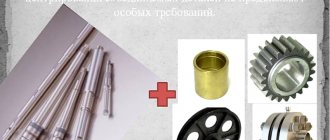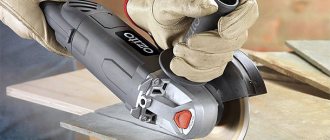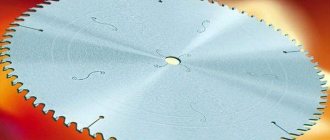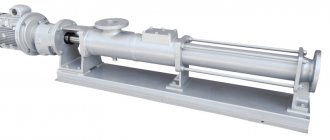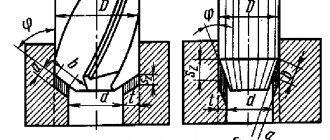A cutting wheel is a type of consumable tool. It is designed for cutting a wide variety of materials. In terms of design, it looks like a disk with a surface on which a layer of abrasive mixture is applied. Rigidity is ensured by fiberglass mesh reinforcement. This technological solution prevents large fragments from breaking off. The destruction of the disk is caused solely by the incorrect choice of cutting mode or failure to comply with the requirements for correct operation.
Types of cutting wheels
Classification by purpose
- Metal discs. Scope of application: cutting reinforcement, profile pipes, steel angles, channels, sheet steel.
- Circles on wood. Also used for cutting plastic pipes, window profiles, plasterboard and MDF boards. Made from high-strength steel, the outer edge of the disc is equipped with sharp teeth.
- Cutting discs for stone. Designed to work with products made of sand-lime brick, paving slabs, stone structures, paving stones, asbestos-cement sheets.
Classification by production technology
Abrasive discs
The base of the metal disc consists of at least two layers of fiberglass mesh, on top of which a mass of abrasive materials is applied:
- corundum;
- silicon carbide;
- electrocorundum.
The technology for manufacturing cutting wheels for metal involves heat treatment, after which the product becomes resistant to destruction. The disc is baked in an oven at a temperature of +2000C.
Depending on the shape, abrasive consumable tools are divided into two types:
- flat disks;
- circles with a concave sleeve.
Diamond wheels
Area of application: cutting particularly durable materials:
- concrete,
- granite,
- marble,
- red brick,
- asphalt,
- stone
Made from steel. An abrasive mass containing diamond chips is applied to the end part of the circle. The width of the diamond-bearing layer varies from 1.5 to 3 mm.
In large-diameter circles intended for pass-through work, the width of the layer of diamond chips can reach 1-2 cm.
There are three types of diamond cutting discs on the market:
- Solid. Designed for wet cutting of materials, it is a solid disc with a continuous diamond edge.
- Segmented. Used for dry cutting. The cutting diamond edge is divided into separate segments.
- Turbo disc. The diamond-bearing edge is made in the shape of a wave. The presence of inclined grooves reduces the contact area with the working material, resulting in natural cooling. The universal wheel is used for wet and dry cutting.
Abrasive material
Wheels for cutting metal are made of silicon carbide (marked with the letter C) and electrocorundum (A). Silicon carbide is a harder material, but inferior to electrocorundum in strength, which is why its use for metal cutting is limited. In addition to the letter designation, the marking contains a number. The larger it is, the higher the quality of the abrasive. Silicon carbide grades: from 52С to 55С – black, 62С-64С – green. Grades of electrocorundum: from 12A to 16A - normal, 22A-25A - white, 32A-35A - chromium, 37A - titanium, 38A (ZA) - zirconium. The cutting ability of zirconium electrocorundum is 10 times higher than normal.
Characteristics of cutting wheels
Bundle type
The strength, productivity and quality of the cut depends on the type of bond. In the production of discs, organic and inorganic binders are used. The first type includes vulcanite and bakelite, the second - ceramic.
Vulcanite binder is a mass of rubber and sulfur that has undergone heat treatment. Discs based on it are characterized by a dense structure and elasticity.
The strength of the vulcanite bonded wheel allows for operating cutting speeds of 50,60 and 80 m/s.
The basis of the bakelite binder is powdered and liquid phenol-formaldehyde resins with fillers. Cryolite, alabaster, and pyrite are used as fillers.
Abrasive wheels on a bakelite bond are characterized by high bending and compressive strength, but they are not resistant to the effects of alkaline cooling water (the alkali content in the liquid should not exceed 1.5%).
The operating speed of circular rotation is over 80 m/s.
The disadvantage of bakelite binder is its low heat resistance: when heated to 2000C, it becomes brittle, and when the temperature rises to 250-3000C, it burns out.
The starting materials for creating a ceramic bond are:
- fire-clay;
- talc;
- liquid glass;
- chalk;
- quartz;
- feldspar.
The ceramic binder increases the water resistance of the abrasive tool; it is characterized by high fire resistance and resistance to chemicals. Disadvantages include sensitivity to impact loads and low bending strength.
Outer and inner diameter of cutting wheels
The market offers cutting discs with outer diameters from 115 to 500 mm. The following are in demand in everyday life:
- diameter 115 mm – designed for small-sized grinders;
- diameters 125, 150 mm – used in angle grinders of medium power and size;
- diameters 180, 230 mm - intended for professional tools.
The diameter of the seat for household tools is most often 22 or 32 mm.
Grain
The characteristic displays the cutting ability of the cutting wheel. The fraction of the abrasive substance varies in the range from 100 to 2000 microns. The higher the grain size, the better the cutting quality.
But at the same time, large abrasive grains reduce the strength of the consumable tool.
Abrasive substance
The performance quality of cutting discs is influenced not only by the grain size, but also by the shape and characteristics of the abrasive substance.
The shape of electrocorundum particles is most suitable for cutting steel products; harder grains of silicon carbide are intended for working with non-metallic materials or alloys of non-ferrous metals.
An important parameter is the heat resistance of the abrasive. Corundum abrasives have the best heat resistance; the operating temperature range of the substance is from 1700 to 19000C.
Diamond abrasives and boron carbide are characterized by the lowest heat resistance - 700-8000C.
Thickness of cutting wheels
The thickness of household cutting discs ranges from 1-5 mm. It is rational to use thin wheels when working with low-power angle grinders.
The smaller the height of the disk, the easier and faster the cutting process occurs - due to the lower resistance of the material. Cutting with a thick wheel will require more effort.
Consumable tools with medium and small outer diameters can have any thickness, circles with large diameters can only have the maximum thickness.
Binding material
The cutting material is reinforced with vulcanite (consisting of sulfur-rubber mass) or bakelite (containing phenol-formaldehyde resins). Vulcanite is a more elastic material, but the speed of the tool is limited to 50-80 m/s.
Bakelite loses strength at a temperature of 200 °C; heating above 300 °C leads to burnout (hence sparking). However, due to its higher speed, Bakelite is more often used in circles intended for cutting metal. The use of this binder material is indicated by the marking BU or BF.
Advantages
The main advantages of abrasive wheels:
- the porous structure ensures natural cooling of the consumable tool;
- the disc does not become dull during operation;
- affordable price;
- large selection of products.
Positive qualities of diamond cutting blades:
- high cutting precision;
- wear resistance;
- there is no strong burning smell;
- minimum number of sparks during operation.
Flaws
The negative qualities of abrasive consumables are:
- formation of a sheaf of sparks during operation;
- the appearance of a strong characteristic odor when cutting;
- rapid wear.
Disadvantages of diamond wheels:
- expensive;
- low heat resistance.
How to choose cutting wheels
The main designations influencing the choice of product are:
- type of compatible equipment (hand tools, stationary equipment);
- best before date;
- abrasive grain size (the smaller the numerical value of the grain size, the larger the grain fraction);
- outer diameter of the circle and seat size;
- thickness of consumable tool;
- maximum number of revolutions (the parameter should not exceed the rotational speed of the power tool);
- operating speed (indicated as a numerical value or marked with a transverse color stripe: yellow indicates speed up to 63 m/s, red – up to 80 m/s, green – up to 100 m/s);
- type of ligament, presence of a reinforcing element;
- purpose of the tool (the type of working material is indicated in the form of a graphic image or color designation).
Color designation of the type of working material
For abrasive wheels:
- green color - stone;
- blue color – steel.
Marking of diamond blades:
- green color – granite;
- blue color – marble, concrete;
- yellow color – tiles, alabaster;
- orange color – brick;
- gray color – granite, ceramics, tiles.
Thickness
Varies between 0.7-4 mm. The choice depends on the diameter of the circle itself and the operations performed. It should be borne in mind that cutting with a thin circle due to the smaller contact area requires less effort and is faster, but the work requires care: if the nozzle is skewed, it may burst. Thickness has virtually no effect on the degree of wear.
In the technical description, the dimensions of the disk, mounting hole and thickness can be indicated both in the metric system and in inches.
Which ones are better
The ideal cutting wheel is:
- Bakelite bonded product with a reinforcing element.
- Type of abrasive: for ferrous metals - simple electrocorundum, for stainless steel products - white electrocorundum.
- The average thickness of a cutting disc for metal is 1.6-2 mm.
- The universal outer diameter for a metal circle for household use is 125 mm.
- For cutting steel structures, it is better to use discs with a fine fraction of abrasive particles.
Diamond cutting
- For dry cutting of structures made of concrete, granite, brick, the ideal consumable tool would be a segmented diamond disc with an outer diameter of 230 mm and a diamond-bearing layer width of 2.5-3 mm.
- To organize furrows for the purpose of further laying utilities, it is better to choose a segmented circle with a diamond-bearing layer of 3.5 mm and a diameter of 350 mm.
- For working with ceramic tiles and marble, a solid diamond-coated cutting wheel is suitable. This cutting method requires mandatory cooling with water.
- For cutting reinforced concrete structures, it is better to use a diamond turbo disc.
Wood cutting wheel
- The best consumable tools for cutting wooden products are carbide discs reinforced with soldering with a high content of tungsten or cobalt carbides.
- The typical thickness of a wood disc is 3.2 mm.
- The universal size of the outer diameter is 130-250 mm.
- The ideal number of teeth for a cross cut is 80-90 cutters, for a longitudinal cut - no more than 60 cutters.
- The optimal angle of inclination of the teeth: for longitudinal cutting - 15-200, for cross cutting - 5-150.
The optimal cutting speed is selected depending on the type of wood:
- for soft rocks – from 50 to 90 m/s;
- for hard rocks – from 50 to 80 m/s;
- joinery wood – 60-80 m/s;
- exotic breeds - 80-85 m/s.
Basic designations
A thorough approach to the selection of abrasive wheels depends on the following criteria:
- Overall circle diameter;
- Thickness of the disk plate;
- Bore diameter (rarely differs from 22.2).
In addition, the basic information usually includes an expiration date.
According to standards, the thickness of a plate with a diameter of 125 mm is from 2.3 mm to 2.5 mm. Discs of 1-1.2 mm are considered thin with the same diameter .
The main information should be looked for on the front surface: the specialization of the wheel will be indicated there - whether it is intended for cutting only steel or is also suitable for non-ferrous metals. There are also universal options. The size of the cutting disc, expiration date and the maximum number of revolutions allowed during use are also indicated there.
Best before date
Usually these numbers, stamped around the mounting hole of the plate, are given little significance. However, cutting disc insist on using the product within the time period they specify: for example, V 01/2018 would mean an expiration date before the beginning of the first quarter of 2018.
External diameter
This most important parameter, in fact, means the class of angle grinder for which the cutting wheel is designed. The following options are common: 115, 125, 150, 180 or 230 mm. It is unacceptable to install a wheel of a larger diameter than it should on the grinder. This is expressly prohibited by safety precautions coupled with common sense. Firstly, the protective casing will interfere, and secondly, the rotation speed of the cutting edge will go far beyond the limits provided by the manufacturer of the power tool, which is highly likely to result in serious injuries and failure of the equipment.
Plate thickness
The thinner the cutting disc, the easier it is to cut through the material: the smaller blade area reduces its resistance. In general, thin plates have many advantages:
At the same time, the disadvantage of this kind of circles is no less obvious: rapid grinding. However, for low-power, battery-powered angle grinders that are not intended for long-term operation without interruption, this type of disc is ideal.
It is worth noting that, subject to safety standards and operational requirements for power tools, neither thin nor thick disks are too dangerous: the reinforcing mesh holds the structure of the plate, regardless of its thickness.
Specification parameters
A specification is a four-character code that encrypts information about the fraction of abrasive grain and the substances that bind it. For example, AS is marked with highly purified white electrocorundum, intended for cutting stainless steel workpieces. The code numbers indicate the grit per unit of disk surface: to work with steel, you will need a coarse-grained cutting wheel marked 30 or 24.
For non-ferrous metals you will need a circle with code 40, or even 60 if the metal is soft. Further, the letter of the Latin alphabet indicates the hardness of the binder component. The closer the letter is to the end, the harder the bond. However, there is an inverse relationship with the hardness of the material being processed, since it is not the bond that cuts, but the abrasive grain.
The last two symbols rarely change and indicate the binding component, which uses the viscous thermosetting plastic Bakelite.
Source
Exploitation
Working with abrasive cutting equipment involves high rotation speeds and requires compliance with safety measures. Before starting work, read the safety precautions specified by the manufacturer.
- Minors and people in a state of intoxication are not allowed to work with cutting devices. The presence of children and animals is not allowed near the work site.
- Carry out cutting work away from flammable materials.
- Use cutting discs only for their intended purpose.
- Before starting the operation, inspect the disc; do not use consumable tools with signs of damage (chips, cracks).
- Do not use expired wheels.
- Follow the rules for storing consumable tools.
- When working with power tools, use personal protective equipment.
Operating rules:
- Before starting cutting work, securely secure the wheel in the power tool.
- Use a tool that has a protective casing that can withstand the impact of a wheel break and catch any splinters.
- When cutting metal, secure the metal structure on only one side; this will help prevent excessive heating and deformation of the material, and, as a result, jamming of the abrasive disc.
- When cutting, keep the wheel straight, applying only radial pressure.
- If intense sparking occurs, cutting work should be stopped for 10-15 seconds, after the specified time has elapsed, continue working at a lower cutting speed.
Installing a cutting wheel into an angle grinder:
- Unplug the power tool.
- Using the special button, lock the rotation shaft.
- Install the disk into the seat.
- Tighten the lock nut and secure with a wrench.
- Before starting cutting work, check the functionality of the disc for 1 minute.
Practical recommendations
First, be sure to run the new cutting wheel idle for about 5 minutes, holding the grinder with the casing on in a circle away from you. The fact is that as a result of possible impacts during transportation, microscopic cracks may form in the body of the circle, leading to the scattering of small fragments.
Gradual wear of the abrasive cutting wheel is accompanied by a reduction in the diameter of the wheel, so in case of repeated use, gradually reduce the cutting depth.
To ensure that water cooling, which is used extremely rarely (for example, when heating the metal being cut), is effective, reduce the wheel speed by 30-50%.
Secure the metal to be cut on one side only. Otherwise, due to strong heating, it will become deformed and the abrasive wheel may jam.
The feed rate of the circle when cutting a thick bar should be reduced by 15-20% while passing half the diameter, after which it can be increased again to the original value.
An abrasive wheel with a bakelite bond should be stored in a dry place, since moisture reduces the strength of the bond over time.
Source: Alexander Chizhov
Manufacturers of cutting wheels
Bosch
The company occupies a leading position in the market of power tools and related products. The range includes abrasive cutting discs for wood, metal and stone, diamond wheels and universal models.
The quality of the company's products meets international quality standards.
Dremel
American brand products are sold in more than 60 countries around the world. The company's product range includes not only high-quality power tools, but also a wide selection of attachments.
Dremel produces cutting wheels for cutting wood, plastic, and metal. Diamond-coated discs can handle concrete, ceramics, marble, and porcelain.
FIT
The Canadian company specializes in the production of tools for household and professional use. The product range includes a wide selection of cutting disc models for metal and stone for household power tools.
FUBAG
The main direction of the German company is the production of high-quality professional equipment for repair and construction work.
The brand's production bases are located in Germany and Switzerland, the company's operating experience is more than 40 years. The catalog offers the consumer high-quality diamond blades for wet and dry cutting.
Husqvarna
Consumable tools from a Swiss manufacturer are characterized by high performance and durability. The company's product range includes a large selection of cutting diamond blades, as well as abrasive products for cutting metal.
The disadvantage of the Husqvarna brand is its rather high cost.
Makita
The company offers a large range of high-quality abrasive discs and segmented diamond-coated wheels. In the catalog you can find both budget models and products belonging to the middle and high price categories.
Master
The company has been supplying construction equipment for 15 years. The product catalog includes consumable tools for cutting metal and wood.
MESSER
The company's catalog includes many models of consumable tools with a wide range of applications:
- segmented diamond blades for cutting concrete and asphalt;
- circles with a continuous edge for cutting ceramic products, marble, porcelain stoneware;
- carbide blades for cutting high carbon steel;
- turbo rims.
Metabo
The German brand specializes in the production of professional power tools and cutting equipment.
The range of consumable tools includes a wide variety of abrasive and diamond discs for angle grinders, as well as saw wheels for wood.
